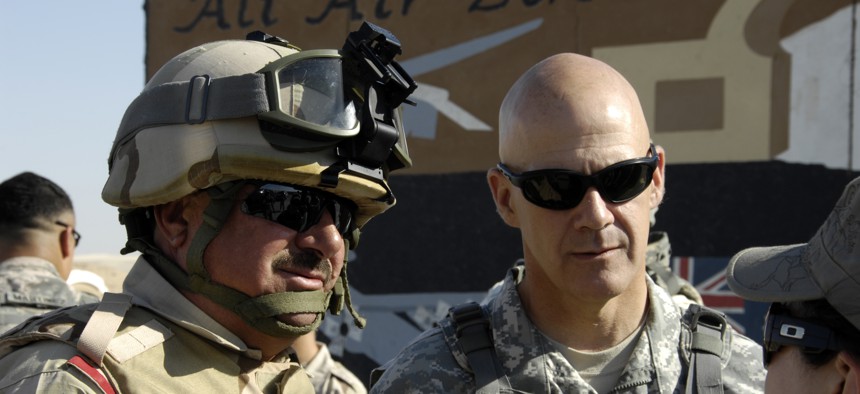
The author—then commander of the 4th Brigade Combat Team, 1st Armored Division—meets with officers of the 10th Iraqi Army Division in southeastern Iraq in 2009. Army / Spc. Ernest Sivia III
Want More Innovation? Get Out of Your Office and Talk to People
Advice from a former leader of the U.S. Army’s Rapid Equipping Force.
It’s no great secret that the Pentagon suffers from innovation inertia. How can we change that? From my experience, change starts with good conversation. Here are three ways to get innovation into your organization’s natural rhythm.
Get on the “battlefield.” Within your organization, you have to know your problem and understand it inside and out. What, exactly, are you trying to solve? Reports and documents will not give you the insight afforded by getting out of the building and talking to people. That’s not just other senior leaders, but the people who are personally struggling with the problem. You may find a problem that exists in one place and think it's exactly the same somewhere else, only to learn that the environment makes it much different. Gaining and internalizing those intricacies is vital.
We’ve learned that getting out and talking to those most affected by your work is revelatory, and leads to further, more niched discussions with unforeseen users. During my time with the Army’s Rapid Equipping Force, our best insights came from dismounted soldiers. They knew what it felt like to run out of battery power midway through a mission, and they told us what they needed in no uncertain terms. These conversations, if patiently pursued, eventually reveal the vital clue to solving the problem.
Make new friends. Once your burgeoning network helps you identify problems and potential solutions, it’s time to find partners: allies beyond your own borders who will help you quickly scale your solution, overcome obstacles, and bolster you through shortfalls.
Finding partners isn’t something to consider when you realize you need them. It has to be an organic and ongoing process founded in trust that starts when you first encounter a challenge to solve. Your early conversations will open discussions about how to build alliances.
We learned a lot from our own failure in this at the REF. We didn’t pursue strategic partners early enough. When it came time to put technology in the field yet we knew we fell short in a particular area, it was too late to go asking for help. Had we started sharing our concerns with both military and non-military entrepreneurs immediately upon learning the source of our problem, we would have had that network in place to jump in at a moment’s notice.
Embrace the MVP. Be aggressive and humble enough to field early or basic solutions. Known in the business world as minimum viable prototypes, or MVPs, these can drive better conversations about the problems and how to fix them.
Don’t seek perfect solutions. These are often dead on arrival, coming too late, or solving a symptom and not the actual problem. The quest for perfection usually leads to things sitting around unused. Likewise, perfecting the ability to solve the right problem slowly doesn’t solve anything today. Instead, narrow your options to those that will scale fast enough to be useful now. Put them into a user’s hands and have an honest conversation: “Does it work? Why not? How can I improve it?” and so on.
In Iraq, our troops struggled with tearing down power lines in small villages every time they drove their armored vehicles through. Rather than spending millions on high-tech innovations, clever soldiers rigged PVC-pipe railings on the hoods of their vehicles to lift and deflect hanging wires. Did it look high-speed? No. Did it get the job done and start a better conversation about the problem? Absolutely.
In effect, if you build a pipeline for driving innovation to support mission acceleration, you’ll do a far better job of sourcing the problems, technologies and people needed to create opportunities to do value-added work.
As defense entrepreneurs wanting to solve difficult problems with revolutionary technology, we can learn much from insurgent tacticians of the past, and sometimes our own innovative troops, who used rugged materials to generate astounding efficacy. If we can pull ourselves away from our attachment to “perfect” solutions and instead develop a good option quickly and maintain fluid communication along the way, we’ll stay two steps ahead of our competitors.
Pete Newell is a retired U.S. Army colonel, former leader of the Rapid Equipping Force, and Chief Executive Officer of BMNT, an advisory company focused on helping the government innovate.






